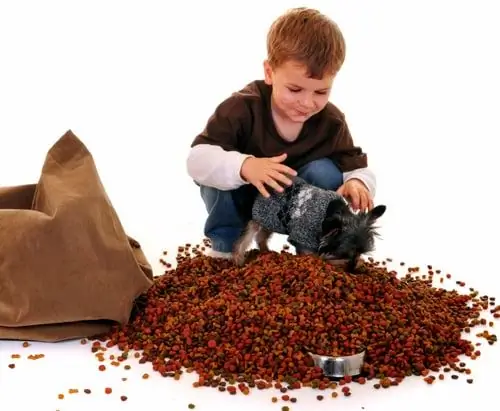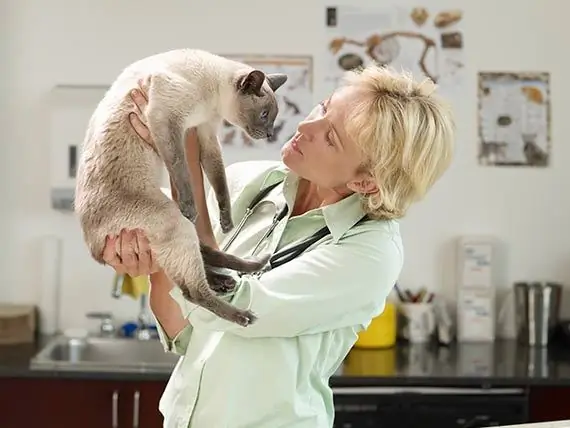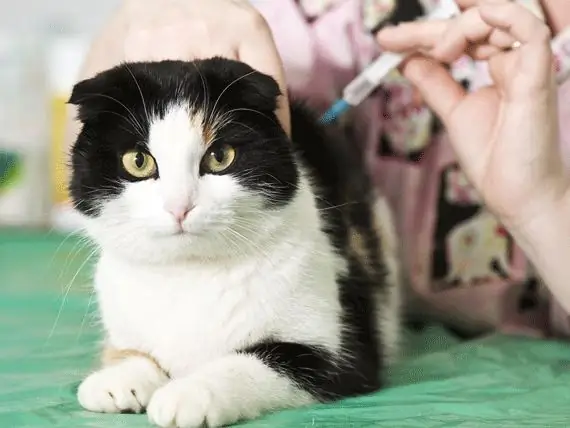
- Зохиолч Daisy Haig [email protected].
- Public 2023-12-17 03:11.
- Хамгийн сүүлд өөрчлөгдсөн 2025-06-01 06:47.
Тэгэхээр ямар ч байсан ичгүүртэй кака тест юу вэ?
Гэрийн тэжээмэл амьтны ар талыг хуванцар саваагаар хугалах нь хангалттай стресст ордог шүү дээ? Тэгэхээр юу гэсэн үг вэ?
Та хэлэхдээ: Хэрэв миний зорилго бол гэрийн тэжээвэр амьтдыг эрүүл, паразитгүй болгох юм бол би таны шийдвэрт итгэх болно, гэхдээ өтгөний шалгалт бол нэг төрлийн харгис бөгөөд ер бусын шийтгэл юм. Би дөчин нас хүртлээ ийм доромжлолыг хүлээж авдаггүй шүү дээ? Баас нь тийм ч тустай биш шүү дээ?
Би хэлье: Эхлэгчдэд та гэрийн тэжээвэр амьтдыг зориг муутай саваанд унагаах шаардлагагүй. Шинэ дээжийг ихэвчлэн жилийн айлчлал эхлэхээс өмнө эсвэл гэрийн тэжээмэл амьтан тань ходоод гэдэсний шинж тэмдэгээр өвдөхөөс өмнө өглөө (эсвэл үдээс хойш) амархан олж авдаг. Энэ тийм ч хэцүү биш шүү дээ. Хэрэв цаг хугацаа яг тохирохгүй бол (сайн үр дүнд хүрэхийн тулд өтгөн нь нэг цагаас хэтрэхгүй байх ёстой), танай мал эмнэлэг таны тав тухыг хангасан супер шинэхэн дээж авчрах эрхийг үгүйсгэхгүй. Амлалт.
Тийм ээ, ялгадсын шинжилгээ нь харьцангуй хямд бөгөөд ердийн боловч зайлшгүй шаардлагатай байдаг. Гэхдээ энэ нийтлэлээс харахад бүх ялгадасын шинжилгээ нь таны гэрийн тэжээвэр амьтанд паразит халдвар авч чадахгүй нь бас үнэн юм. Тиймээс жил бүр ба / эсвэл цуврал ялгадсын үзлэг хийх шаардлагатай байж магадгүй юм.
Одоо туршилтын үндсэн зорилго:
Малын эмч нар таны гэрийн тэжээвэр амьтдын ходоод гэдэсний замд орж болзошгүй шимэгч хорхойг байнга эрэлхийлж байдаг. Мэдээжийн хэрэг, хүмүүс бид ч гэсэн шимэгч хорхойтой болох боломжтой, гэхдээ бидний орчин үеийн амьдралын хэв маяг нь шимэгч хорхойг халдварлах чадваргүй болох хандлагатай байдаг. (Та хамгийн сүүлд хэзээ ганц удаа муурны хошоонгоор амьсгалах гэж хашаандаа уруулаараа газар хамхиж байсан бэ?)
Тиймээ, гэрийн тэжээвэр амьтад маш олон шимэгчтэй болдог. Энд миний харж байгаа хамгийн түгээмэл ходоод гэдэсний шимэгчдийн түүвэрлэлт байна [Өмнөд Флоридагийн хагас халуун орны паразит тэнгэрт]
Нохой, муурны дугуй өт.
Гэрийн тэжээвэр амьтдын дэгдээхэйн өт
Гэрийн тэжээвэр амьтдын whipworms
Гэрийн тэжээвэр амьтдын Giardia

Гэрийн тэжээвэр амьтдад элэг томрох
Гэрийн тэжээвэр амьтдад элэг томрох
coccidia in pets
i’ll not go into the gory details on each but you can click on the links and check out the info for a better understanding of how these parasites can potentially affect your pets and even your human family.
sure, pet-popular parasites don’t often infect humans in the so-called, “developed” nations all of you reading this likely live in, but that doesn’t mean it doesn’t happen. roundworms and hookworms are still a factor in humans in the us, as is giardia, which will give you the nastiest case of diarrhea you can imagine short of amoebic dysentery.
since veterinarians are also on the front lines when it comes to public health, consider that fecal exams are not just necessary for healthy pets, they’re essential for healthy humans, too, more so if your family members are very young children, very old adults or otherwise immunocompromised (transplant patients, hiv-positive humans, chemo recipients, etc.).
how do we identify these critters in the fecal exam?
the short answer: with a microscope.
the long answer: we take a tiny sample of your pet’s stool (very fresh is always best). a few grams is enough (think an eighth of a teaspoon if that’s easier). then we put it through one of three processes.
1. the smear: we take about a half gram of stool and smear it onto a microscope slide to search for parasites (and bacteria) directly. many times we’ll see them swimming about. finding evidence of parasites in a simple smear is often indicative of severe infection.
2. the float: this method relies on mixing the stool with a special solution. it filters out the big pieces of stool in a tube or other cylindrical vessel and allows the eggs and other small critters to float up to the top, buoyed by the solution’s specific gravity. a microscope slide’s cover slip is typically used to recover the floaters. some parasites, however, aren’t amenable to flotation. eggs seem to do best through this method.
3. centrifugation: spinning the heck out of stool in a centrifuge when it’s mixed in a sugar solution picks up about 50% more parasite eggs and oocysts than through flotation. therefore, i like this method best for worm eggs, giardia, and coccidia--though i’d never go without a smear. problem is, most hospitals don’t yet use this method. it’s more expensive than others and research demonstrating it’s much greater efficacy is fairly recent.
so now you know the truth: not all fecal exams are created equal. not only does this test rely on careful selection of materials and methods, it also requires a trained eye. in our practice, for example, one of our techs detects parasites about 50% more often than the veterinarians and other techs/assistants. (that’s why we also do floats so that she can check them all at her convenience when she comes back from her day off.)
it’s also true that even a parasite-infected animal will often not come up positive on a fecal test. human error and equipment choice are factors, but so is the parasite itself. sometimes they do not make themselves known in the stool. worms sometimes aren’t shedding their eggs and subclinical (low-grade or smoldering) infections may not reveal much, either.
again, that’s why it’s important to perform this test as often as is reasonable. for all dogs and cats at least three times during the first few months of life. i want to see at least two negative tests in a row, a month apart, before i’ll feel comfortable that my patient is parasite-free.
for adults, once a year is great--that is, unless they show gastrointestinal illnesses. in this case, serial fecal tests make sense--or at least one every time the symptoms recur until a definitive diagnosis is made (whether it’s parasites or something else).
ultimately, fecal tests are a critical component of our veterinary hat of tricks. doing without may seem like the economically wisest thing in the absence of gastrointestinal symptoms, but consider: parasites can wear pets down in ways you might not expect. and it’s never wrong to be too safe in the presence of diseases that may also affect your family. ‘nuff said.
Зөвлөмж болгож буй:
Таны гэрийн тэжээмэл амьтны хоолны аяганд үл үзэгдэх аюул

Америкийн Хүүхдийн Анагаах Ухааны Академийн (AAP) саяхны хийсэн судалгаагаар гэр бүлийн тэжээвэр амьтдыг хооллох нь нялх хүүхдүүдийн сальмонеллагаар хордох гол шалтгаан болж байна. 2006 оны 1-р сараас 2008 оны 10-р сар хүртэл Пеннсильванийн гэрийн тэжээвэр амьтдын үйлдвэрлэдэг үйлдвэртэй холбоотой сальмонелла өвчний дэгдэлт гарч, хоол тарааж байсан 21 муж даяар нийт 79 хүн өвчтэй болжээ. Гэрийн тэжээвэр амьтдын хуурай хоолонд илэрсэн сальмонеллын хордлогын 79 тохиолдол бүртгэгдсэнээс оношлогдсон өвчтөний 32 нь
Таны гэрийн тэжээмэл амьтан таны гэрийн тэжээвэр амьтны урьдчилсан мэдээг хэрхэн тодорхойлох вэ?

"Бид урьдчилсан таамаглалын тодорхой хүчин зүйлүүдэд хэт их анхаарлаа төвлөрүүлэхэд илүү том дүр зургийг харахаа болино." Доктор Интиль өвчтөнүүдийнхээ асрамжийн талаар зөвлөмж гаргахаасаа өмнө амьтан бүр өвөрмөц бүтээгдсэн организм бөгөөд олон хүчин зүйлийг жинлэн үзэх шаардлагатай гэдгийг санахад анхаарлаа төвлөрүүлдэг. Гэрийн тэжээвэр амьтдын "урьдчилан таамаглах хүчин зүйл", эмчилгээг хэрхэн тодорхойлдог талаар өнөөдрийн Daily Vet дээрээс илүү ихийг олж мэдэх
Цусны судалгаагаар гэрийн тэжээвэр амьтанд таны гэрийн тэжээмэл амьтны эрүүл мэндийн талаар юу хэлэх вэ?

Гаднах төрхтэй адил эрүүл чийрэг байх, эсвэл өмнө нь оношлогдсон эрүүл мэндийн байдлыг хянахын тулд цусны судсыг хийдэг. Энэ нь хамтрагч амьтдын хувьд мөн адил юм. Цусны шинжилгээгээр малын эмч танд юу хэлж болох талаар илүү ихийг олж мэдэх
Таны гэрийн тэжээмэл амьтны амьдралын хэв маяг, хоолны дэглэм таны талаар юу гэж хэлдэг вэ?

АНУ-ын хүн ам эрс өссөн тул тус улсын гэрийн тэжээвэр амьтад ч мөн адил өсчээ. Доктор Коутс гэрийн тэжээвэр амьтад гэрийн тэжээвэр амьтдынхаа амьдралын хэв маягийн сонголтыг өөрсдийн хийх ёстой зүйлээс илүү ихээр хуваалцдаг болохыг харуулсан хамгийн сүүлийн үеийн тоонуудыг авч үзэв
Гэрийн тэжээмэл амьтны хоол бол зөвхөн гэрийн тэжээмэл амьтны хоол биш юм

Америкчуудын хувьд хоол нь хүний энергийг нөхөх цаг хугацаатай адил нийгмийн үүрэг юм. Үйлчилгээний байгууллагатай өглөөний цай, найзтайгаа кофе, хөнгөн зууш, бизнесийн үдийн хоол, хамт ажиллагсаддаа танигдсан оройн хоол, машинд байрлуулсан хөл бөмбөгийн бургер зэрэг нь хоол тэжээлээс илүүтэй нийгмийн харилцаанд чухал ач холбогдолтой юм. Үнэндээ ухаалаг хоол хүнс, тоо хэмжээг сонгох нь ерөнхийдөө хойш тавигддаг. Америкчуудын жингийн асуудалд хооллолтын нийгмийн талууд ху
